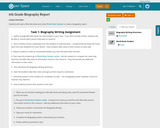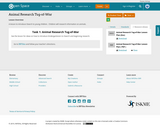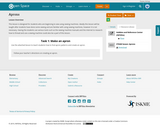
Students will read a Who Was Book and utilize World Book Student to create a biography report.
- Subject:
- Information, Media and Technological Literacy
- Material Type:
- Lesson Plan
- Author:
- Melissa Fortman
- Date Added:
- 04/18/2019

Students will read a Who Was Book and utilize World Book Student to create a biography report.

This resource takes an exploratory look at duikers, small antelopes that inhabit forest or dense bushland in East Africa. Content includes information on the duiker's physical characteristics, habitat, behavior, diet, caring for the young, and predators.

Resource takes an exploratory look at the topi, one of the most socially advanced antelopes. Content includes information on the topi's physical characteristics, habitat, behavior, diet, caring for the young, and predators.

The life and times of Ulysses S. Grant are surveyed in this companion site to the PBS series. Features include a transcript of the program as well as video clips, interactive games, and learning activities.

A lesson to introduce ISearch to young children. Children will research information on animals.

This lesson is designed for students who are beginning to sew using sewing machines. Ideally this lesson will be taught after students have done some sewing and are familiar with using sewing machines, however it is not necessary. Having the students use various tools such as the sewing machine manuals and the internet to research how to thread and use a sewing machine could also be a part of this lesson.

See the many birds that spend their summer in the Arctic in this video segment from Nature. [2:52]

This site from atozteacherstuff.com provides a lesson to help students develop an appreciation for poetry. This site will also will help create meaning from poetry.

Use this assessment to see what your students have learned about adaptations. This type of assessment allows students to observe and make open-ended claims backed up by evidence. Included are a power point presentation, student quiz, and a video explanation.

Lesson plan in which students calculate area, build areas to a given amount, and calculate the perimeter with the use of Legos. Step by step instructions and videos are provided. CCSS.Math.Content.3.MD.C.7.c Use area models to represent the distributive property in mathematical reasoning.

This third grade lesson plan engages students in comparing and contrasting paired informational text passages about frogs. Students will use a Venn Diagram to keep track of the information.

Students will write an informative sentence in response to listening to the story "Does A Kangaroo Have a Mother Too?". Included in this lesson are videos of mother and baby animals, pictures of the lesson in action, and a video of student oral presentations.

Students will complete a double bubble thinking map by sorting facts that go with Washington, Lincoln or both. Also included in this plan is an art project, worksheets, and video of the lesson in action. Great activity to use after reading about Washington and Lincoln!

What is autism? How does it affect behavior? Students will find evidence of the author's tone or purpose for writing the article, as well as hints that show evidence of opinion. Includes a video clip from the movie "Rainman", and an article about autism to read and annotate.

Through the story, Look Out Kindergarten, Here I Come, students find out about Henry and his new kindergarten class. As a class, they write about what it is like in kindergarten class.

Students will participate in a picture walk through the expository text "Seasons and Weather". The purpose of the picture walk is to prepare the students for reading the story and gives them practice in using picture clues to make meaning. It gives them a sense of the text and an idea of what they will be reading about.

The class will read the informational text "Together They Were Better". As the teacher reads the book aloud, she/he will use the illustrations from each page to give students clues as to the text on the page, helping them to see the relationship between the pictures and the words. The powerpoint of the book is included, as long as extension activities.

Students will have the opportunity to work collaboratively by using the Think-Pair-Share technique to ask questions about a story. Included are examples of student's questions, and a Think-Pair-Share poster and document.

Read, write, and present a digital narrative with transition words to help us put the events in order! After modeling the lesson, groups of students will write narratives to recount a short sequence of events, they will include details and using temporal words to signal event order and provide a sense of closure. They will use digital tools to produce and publish writing. Materials, links, and examples of student's work are included.

Students will solve word problems to create their own subtraction number sentences. They will use known addition facts to solve subtraction problems. A detailed lesson plan, worksheet, and pictures/videos of the lesson being modeled are included.